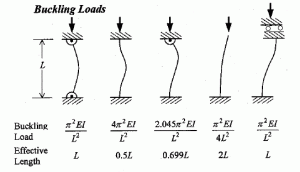Twelve Viva Questions on Columns and Struts
Q.1. Define column.
Answer.
A bar or a member of a structure inclined at 90° to the horizontal and carrying an axial compressive load is called a column.
Q.2. Define strut.
Answer.
A bar or a member of a structure in any position other than vertical, subjected to an axial compressive load, is called a strut.
Q.3. Define slenderness ratio.
Answer.
The ratio between the length of the column and the minimum radius of gyration of the section is called the slenderness ratio.

Q.4. Define buckling load.
Answer.
The maximum limiting load at which the column tends to have lateral displacement or tends to buckle is called a buckling or crippling or critical load.
Q.5. Define equivalent length.
Answer.
Equivalent length for a column is the length which gives the same buckling load as given by both ends hinged column.
Q.6. Define crushing load.
Answer.
The maximum axial compressive load which a column can take without failure by crushing is called crushing load.
Q.7. Name various types of columns.
Answer.
- Long columns,
- Intermediate columns,
- Short columns
Q.8. Write Euler’s formula for buckilng load.
Answer.





Q.9. Write Rankine-Gordon’s formula for critical load.
Answer.









Q.10. Write modes of failure in case of columns.
Answer.
- By buckling alone,
- By crushing alone
- By both buckling and crushing.
Q.11. Write factors affecting strength of a column.
Answer.
The strength of a column depends upon the following factors:
- End conditions of the column,
- Slenderness ratio of the column (which depends upon the length and cross-section of the column),
- Material of the column.
Q.12. Write the assumptions made in the Euler’s column theory.
Answer.
The following assumptions are made while deriving Euler’s formula
- The material of the column is homogeneous and isotropic.
- The compressive load on the column is fully axial.
- The column fails only by buckling.
- The weight of the column is neglected.
- The column is initially straight and buckles suddenly at a particular load.
- Pin joints are friction-less and fixed ends are rigid.
- The cross-section of the column is uniform throughout its length.
- The length of the column is very large as compared to the cross-sectional dimensions of the column.
- The direct stress is very small as compared to the bending stress.


6 Responses to “Twelve Viva Questions on Columns and Struts”
Benjamin Maxwell
How would you work out how far a load can be moved of centre on a column
VIHARIKA
we need some more questions..thanks for this questions..
admin
We will post for sure.
Thanks
soumya
Thanks & i really appreciate to this site
yohannes
t
AVANISH SINGH
Why are used min. Value of moi